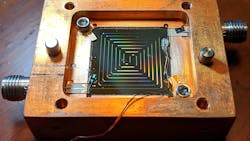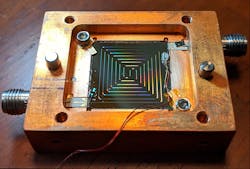Simple Thermometer Uses Frequency Changes to Measure Cryogenic Temperatures
Researchers at the National Institute of Standards and Technology (NIST) have invented a miniature thermometer that could be used to monitor the cryogenic temperatures of processor chips in superconducting quantum computers, which must stay cold to work properly.
The thermometer consists of a superconducting niobium resonator coated with silicon dioxide. The coating interacts with the resonator to shift the frequency at which it naturally vibrates. Scientists suspect this is due to atoms “tunneling” between the two sites, a quantum-mechanical effect.
The NIST thermometer works on the principle that a resonator’s natural frequency is a function of its temperature. The thermometer measures changes in frequency, as measured by electronics, then maps those changes to a temperature. By contrast, conventional thermometers for sub-Kelvin temperatures rely on measurements of electrical resistance. They require wiring routed to room-temperature electronics, making the final device more complicated (and more expensive), and potentially interfering by adding heat.
The NIST thermometer measures temperature in about 5 msec (thousandths of a second), much faster than most conventional resistive thermometers which take about one-tenth of a second. The NIST thermometer would also be easy to fabricate and requires only a single manufacturing process step. They can be mass-produced, with more than 1,200 fitting on a 3-in. (approximately 75-mm) silicon wafer.
The new superconducting thermometer measures temperatures below 1° kelvin (272.15°C or 457.87°F), down to 50° millikelvin (mK) and potentially 5 mK. It is smaller, faster and more convenient than conventional cryogenic thermometers for chip-scale devices.
Measuring just 2.5 × 1.15 mm, the new thermometer can be embedded in or stuck to another cryogenic device to measure its temperature when mounted on a chip.
The technology is a spinoff of NIST’s superconducting sensors for telescope cameras, specifically microwave detectors delivered for the BLAST balloon
The new thermometer will let researchers measure temperatures on a wide range of components in test packages at very little cost and without needing a large number of additional electrical connections. This should be a boon to researchers working in quantum computing.

